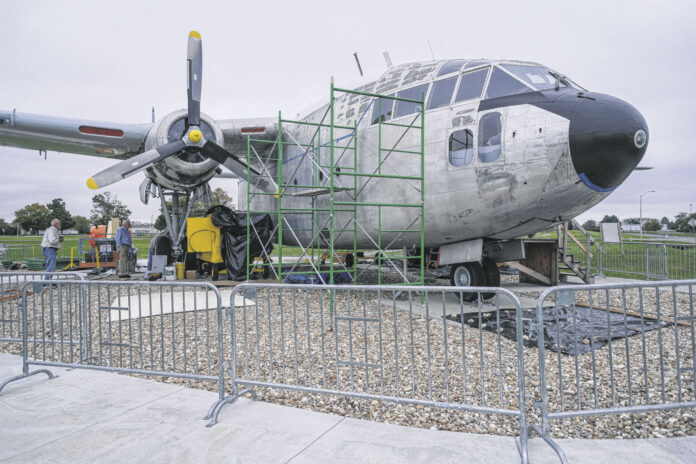
Volunteers working on a project to restore a C-119 “Flying Boxcar” aircraft at the Atterbury-Bakalar Air Museum are repainting the plane before winter weather arrives.
The aircraft is on display near the museum and Columbus Municipal Airport.
The museum purchased the C-119 for $15,000 in 2019.
The roughly 38,000-pound plane, which is not airworthy, was taken apart last year at an airport in Greybull, Wyoming, where the aircraft’s parts were loaded onto trucks and driven 1,460 miles to Columbus. At an airport restoration hangar, much of the aircraft was gradually reassembled and restored over the course of several months.
Skip Taylor, who is co-leading the project, said that the goal is to finish painting the plane before winter arrives.
“That’s been a challenge because we’ve had a lot of rain,” he said.
Once volunteers are finished, the plane will be mostly gray, with white on top and black behind the engines.
The exterior work has also included removing old black paint. “The aircraft was painted black beneath the engines to hide the stains from the engine exhaust and from oil leaking from the engines,” museum officials said. “This residue, merged with 3 coats of black paint, makes it a challenge to remove.”
The paint removal process involves coating the old black paint with paint remover, letting it soak and then scraping off the softened paint. This must be done several times to remove all layers. There is also some old grey paint that needs to be removed, but officials said it comes off with less difficulty.
Team members have also worked on adding an electric meter and circuit breaker box to the aircraft’s power cart, which also contains a heat pump and air conditioner.
The plane is expected to have electric power soon, which Taylor said will be used for lighting and HVAC. The HVAC, which will heat and cool the inside of the plane, is already “roughed in,” as is much of the interior wiring.
In addition to working at the display site, the C-119 team has also been able to use the Columbus Propeller makerspace for some work on the project. Taylor said the work there has included pre-assembly of air control surfaces, which will be added to the plane once painting is finished and help “complete the look.” They’ve also used the space as a paint kitchen.
The team has begun ordering lettering for the plane, which will have numbers, as well as Air Force “bars and stars,” Taylor said. Seats are out for upholstery, and they’re also “chasing down some leaks in the plane.”
“There will always be a project here or there that will add to the completion,” he said. However, he expects the initial phase of the C-119 project to be complete soon.
Some possible future additions might include putting in insulation and fabricating items such as a navigator’s desk, toilet, seats, fold-down litter, and crates to help hide the HVAC system.
The C-119, also known as the “Flying Boxcar” due to the unusual shape of its fuselage, was in service with the U.S. Air Force from 1947 to 1972 and was designed to carry cargo, personnel, litter patients and mechanized equipment. The aircraft was also used to drop cargo and troops using parachutes, according to the Strategic Air Command and Aerospace Museum.
The Flying Boxcars were powered by two Wright R-3350 Duplex Cyclone radial engines, each with 3,500 horsepower, and could reach a maximum speed of 296 miles per hour.
The U.S. Air Force extensively used C-119s during the Korean War from 1950 to 1953. Retired C-119s were also used as air tankers to fight wildfires in the United States.
The particular C-119 purchased by the museum was built in Hagerstown, Maryland, for the Canadian Air Force, Taylor said. The aircraft was later acquired by Hawkins & Powers and used to fight forest fires. Its last known flight was in 1990.
The Flying Boxcars are of particular historical significance to Columbus, according to museum volunteers. Here, the pilots referred to them as the “Dollar Nineteens,” according to museum records.
From 1957 to 1969, 36 C-119s for the 434th Troop Carrier Wing were stationed at Bakalar Air Force Base, which is now Columbus Municipal Airport. The C-119s were a staple in Columbus, flown out of the base longer than any other aircraft.
Manufacturers Fairchild and Kaiser built 1,151 of the C-119s from 1949 to 1955. However, only around 40 Flying Boxcars are still left today, most of them in museums across the country or in a scrap yard.




